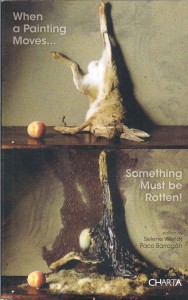« Related Readings
When a Painting Moves… Something Must be Rotten!
 When a Painting Moves… Something Must be Rotten! Edited by Selene Wendt and Paco Barragán. Edizione Charta, Milano and The Stenersen Museum, Oslo, 2011. 76 pages. ISBN 9788881588169.
When a Painting Moves… Something Must be Rotten! Edited by Selene Wendt and Paco Barragán. Edizione Charta, Milano and The Stenersen Museum, Oslo, 2011. 76 pages. ISBN 9788881588169.
By Irina Leyva-Pérez
Artists have always crossed the boundaries and pushed the limits by proposing new approaches to art. This attitude has become an intrinsic part of contemporary art, and recurrently we see artworks that escape the traditional description. Artists are using all the resources at their disposal to make art, so it is not a surprise that technology, which is constantly evolving and such a big part of our daily life, has become a component of this mix and match. Painting, despite being one of the oldest techniques in the history of art, suffered a ‘revamp’, and artists challenge it by trying to emulate it and recreate it with other media. When a Painting Moves… Something Must be Rotten! is a compendium of texts about this transition in contemporary art and how it has become a trend.
Divided into two parts, the first one contains essays by F. Javier Panera Cuevas, Selene Wendt, Paco Barragán and Fabián Marcaccio. These essays support the idea of painting ‘as a moving image’ versus the traditional technique. The second part is dedicated to interviews of artists such as Bill Viola, Sam Taylor-Wood, A.K. Dolven, Ori Gersht and Crispin Gurholt, among others, whose work embodies this principle. The book was made after the exhibition with the same title, which presented the work of several artists that explored this concept. The idea of a ‘moving painting’ and the ‘pictorial’ expanding beyond the traditional canvas is the central axis of this book, as it was of the exhibition. The authors explore ideas such as the possibility of ‘making a painting’ through digital technology and the validity of such.
This trend is to some extent a result of the appropriations of the 1980s, followed by a conscious deconstructive approach in which contemporary artists are ‘dissecting’ art masterpieces and reinterpreting them. The fact that artists today are concerned with similar preoccupations of those which occupied them centuries ago, makes themes such as mortality, love, sex and posterity possible to resurface again, hence the ‘search back in time.’ There is a sense of historicism behind the work of these artists, and also a sense of revisionism and acceptance. Their work is a clear statement supporting the notion that art history has a lot to offer, and in reexamining the work of the masters, other artists can find inspiration.
The second part of the book brings in the vital experience of the artists. By interviewing them, the authors are reaffirming the conscious approach they are taking, and that this trend is not pure accident but the end result of a careful study.
This book explores essential aspects of this trend, how it is, among other things, a progression that happened consistently with the development of art and technology, especially to the point in which technology became a tool for artists. The idea that ‘something’ is not right because is not fitting the quintessential and traditional idea of art is left behind forever.
Irina Leyva-Pérez is an art historian and critic based in Miami. She is the curator of Pan American Art Projects.


































